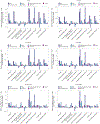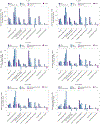Children's and adolescents' rising animal-source food intakes in 1990-2018 were impacted by age, region, parental education and urbanicity
- PMID: 37117550
- PMCID: PMC11533124
- DOI: 10.1038/s43016-023-00731-y
Children's and adolescents' rising animal-source food intakes in 1990-2018 were impacted by age, region, parental education and urbanicity
Abstract
Animal-source foods (ASF) provide nutrition for children and adolescents' physical and cognitive development. Here, we use data from the Global Dietary Database and Bayesian hierarchical models to quantify global, regional and national ASF intakes between 1990 and 2018 by age group across 185 countries, representing 93% of the world's child population. Mean ASF intake was 1.9 servings per day, representing 16% of children consuming at least three daily servings. Intake was similar between boys and girls, but higher among urban children with educated parents. Consumption varied by age from 0.6 at <1 year to 2.5 servings per day at 15-19 years. Between 1990 and 2018, mean ASF intake increased by 0.5 servings per week, with increases in all regions except sub-Saharan Africa. In 2018, total ASF consumption was highest in Russia, Brazil, Mexico and Turkey, and lowest in Uganda, India, Kenya and Bangladesh. These findings can inform policy to address malnutrition through targeted ASF consumption programmes.
© 2023. The Author(s).
Figures













Comment in
-
A global view on animal-sourced food on children's plates.Nat Food. 2023 May;4(5):358-359. doi: 10.1038/s43016-023-00760-7. Nat Food. 2023. PMID: 37138017 No abstract available.
References
-
- The State of the World’s Children 2019: Children, Food and Nutrition: Growing Well in a Changing World (UNICEF, 2019); https://www.unicef.org/reports/state-of-worlds-children-2019
-
- Malnutrition Data (UNICEF, WHO & World Bank, 2021); https://data.unicef.org/resources/dataset/malnutrition-data/
-
- Swinburn BA et al. The global syndemic of obesity, undernutrition, and climate change: The Lancet Commission report. Lancet 393, 791–846 (2019). - PubMed
-
- Caulfield LE et al. in Disease Control Priorities in Developing Countries (eds Jamison DT et al.) Ch. 28 (The International Bank for Reconstruction and Development/The World Bank & Oxford Univ. Press, 2006). - PubMed
-
- Global Obesity Observatory (World Obesity, 2022); https://data.worldobesity.org/tables/prevalence-of-child-overweight-incl...
Publication types
MeSH terms
Grants and funding
LinkOut - more resources
Full Text Sources

